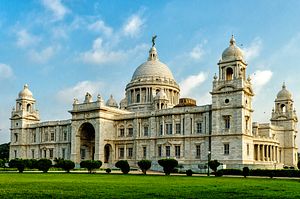Rudyard Kipling is looking up from a half-empty piece of paper. The pen in his hand hangs just above the white space that awaits to be filled with ink. The writer appears to be waiting for an inspiration, or perhaps he is just searching for the best expression of his thoughts. His eyes are directed towards somewhere beyond, his lips hidden under the bushy moustache.
This is a newly discovered depiction of Rudyard Kipling, currently on display at the Victoria Memorial Hall in Kolkata (which is where your correspondent recently had a chance to see it; one can also have a look at it here). It is there that the work was found during the cataloging process, adding to an impressive collection of paintings by British artists that the Victoria Memorial already possesses (you can browse the collection – and see some of it in miniature – here). Victoria Memorial and this particular painting have one more thing in common: The creation of both was ordered by Lord Curzon, the viceroy of India. The Victoria Memorial Hall was Curzon’s idea to commemorate Queen Victoria soon after her death. The monument was built in Kolkata, the then capital of British India. Despite Curzon’s mixed legacy in India (and particularly in Bengal, where Kolkata is located) his statue still stands just outside the memorial. Curzon was also an admirer of Kipling’s works and he, according to the information provided by the Memorial’s authorities, commissioned the painting in 1914.
The task was fulfilled by Sir Phillip Burne-Jones and here also the connection goes far beyond the painting itself. Phillip Burne-Jones’ mother was Georgiana Burne-Jones (born MacMonald) and his father was Edward Burne-Jones; both parents were painters. One of Georgiana’s sisters was Alice, who had married John Lockwood Kipling and gave birth to Rudyard Kipling. Apart from this family connection, Phillip Burne-Jones’ best known painting is The Vampire and it, in turn, inspired a poem by Kipling bearing the same name.
In 1914, the year when the painting was commissioned, Kipling had long since returned to England, after a period of working as a journalist in India (where he had been born). By 1914, most of his works, including some of the most acclaimed, such as Kim, the Jungle Book and The Light that Failed, had already been published. It was also in 1914 that Kipling was asked by the government to support Britain’s war effort with his witty and able pen. He also continued to publish after the war. The painting, therefore, shows Kipling exactly as he was at this stage of his life: with his page half full but with so much still to be written.

































